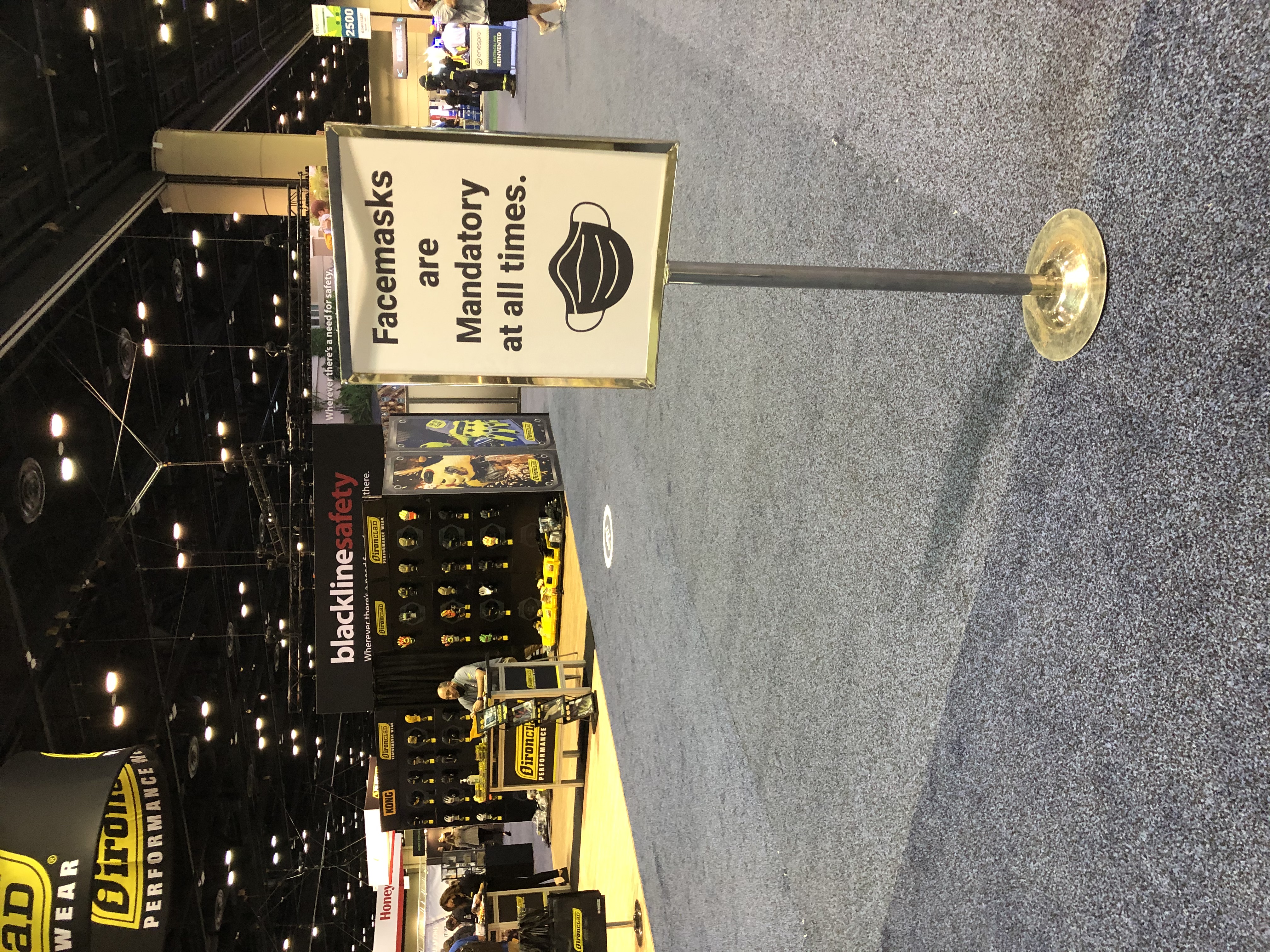At the National Safety Congress: Topics du jour

From internet forums you get a good idea of the workshops at the Congress and what is on the minds of EHS professionals:
Anybody want to share Environmental Best Practice for the benefit of the Group? Can good Environmental Management add to the bottom line?
I'll kick off with the fact that we use a shredding machine to shred up to 70% of our waste Cardboard for use as a parts packaging material - benefits and points of interest?
1) We have eliminated the need (and cost) to buy specialist materials for packing our product.
2) We have significantly reduced the amount of waste leaving our facility as waste.
3) We have EPA permission to shred waste card from other group sites
4) We measure the material produced and capture within our waste metrics
5) We have encouraged some 3rd party packers to adopt a similar approach
6) Our client fully supports it
7) No related quality issues or negative feedback in 8+ years of use within world wide parts distribution operation
8) Positive comments received indicated the shred is better than the previous 'specialist' material.
A potential easy 'win/win' if your processes includes 'pack out' of finished product
New criteria of OSHA state plan states
Following several months of discussions, the Occupational Safety and Health Administration has updated the factors it uses to measure how effectively states enforce workplace safety and health regulations.
The new list places more emphasis on how fast states respond to and investigate complaints, how they assess penalties, and whether workers accompanied compliance officers during inspections.
The changes to the “state activity mandate measures” were announced in an Oct. 11 memorandum from David Michaels, assistant secretary of labor for occupational safety and health, and took effect Oct. 1. They will be used starting with the quarterly reviews for fiscal 2013.
The measurements are:
• planned versus actual inspections;
• percent of inspections in the public sector;
• percent of inspections where establishments were found in compliance;
• average number of violations per inspection;
• average current serious penalty, with a breakout by total and size of employer;
• percent of high-hazard establishments inspected;
• percent of penalty retained after reductions;
• percent of fatalities responded to within one day;
• number of open, noncontested cases with incomplete abatement more than 60 days after citations were issued;
• average number days between an inspection's opening conference and issuing citations;
• average number of work days to initiate complaint investigations;
• average number of work days to initiate complaint inspections;
• percent of imminent danger complaints and referrals responded to within one work day;
• number of inspections where entry was denied and entry was not obtained;
• percent of safety whistleblower investigations completed within 90 calender days;
• average number of calender days to complete a safety whistleblower investigation;
• percent of safety whistleblower complaints determined to have merit; and
• percent of initial inspections with employee representation during the walk-around by inspectors or employee interviews.
When judging how states are performing, OSHA reviewers will compare the results with federal OSHA's results and expectations. For example, OSHA expects all fatalities to be responded to within one work day. Also, a state's average number of violations per inspection should be within plus or minus 20 percent of the federal average for the past three years.
The 18 new measurements replace a list of 15 data points OSHA used for previous state reviews. The new lists places more emphasis on how fast states respond to and investigate complaints, assess penalties, and whether workers accompanied compliance officers during inspections.
All the measures were discussed at a June 25 public meeting in OSHA's Washington, D.C., headquarters or in written comments submitted to OSHA (42 OSHR 735, 8/16/12).
The measures were also discussed during gatherings of a panel of OSHA and state plan officials, known as the At Least as Effective Workgroup.
Workplace violence
What to do if someone fires a gun at work
How would you respond if someone opened fire at work? How should you respond? And what can you do to prevent such a thing from happening in the first place?
Local law enforcement officers tackled those questions Wednesday afternoon at a lunch presentation hosted by the South Coast Metro Alliance's Business-Police Partnership.
The event brought together various public safety agencies, area business leaders and school officials. About 64 people attended the lunch at the DoubleTree Hotel in Santa Ana. The alliance represents businesses near South Coast Plaza, where Costa Mesa and Santa Ana share a border.
In the wake of recent high-profile active shooter situations, like the Aurora, Colo., movie theater shooting, speakers said it's more important than ever to have an emergency plan in place and to understand how best to help first responders if an incident does take place.
Above all, speakers emphasized awareness about active-shooting incidents, which are loosely defined instances of killing or attempted killing in a confined, populated space, usually using firearms.
Taking the attitude that "it couldn't happen here," speakers said, could be a dangerous mistake.
"You have to understand this isn't just your workplace anymore," said Craig Farrow, assistant director of South Coast Plaza Security, who helped organize the event. "This is anywhere you may go."
Shawn Dyball, an investigator with the Orange County Intelligence Assessment Center, discussed methods for recognizing possible danger before workplace or school shooters reach a violent "flashpoint."
"The key here is that it's preplanned. Active shooters don't just snap," she said. "Somebody that conducts the shooting in the workplace, with very, very few exceptions, they don't just happen to have a gun handy, get pissed off and decide to go shoot somebody that they don't get along with."
Instead, most shooters have become hostile over a longer period of time, sometimes as a result of work-related stresses, or issues in their home lives, she said.
Members of the audience gasped when Dyball said many shooters involved in past killings practiced using weapons in the time leading up to the events, as in the case of the 2007 Virginia Tech massacre.
Safety kickoffs
By John Drebinger
In order for any event or activity to be successful, it is critical that you begin by knowing your outcome. Ask yourself and your team members – what do we want the result of our safety kickoff to be?
• Being able to stay focused on safety and knowing how to regain focus when it is lost.
• Actively watching out for their fellow workers’ safety and taking action when they see someone near a hazard or doing an unsafe act.
• Replacing shortcuts with the safest behavior thus effectively eliminating shortcuts.
• Having everyone take personal responsibility for their own safety.
Ultimately, the outcome of all safety meetings is to improve safety performance and to eliminate injuries. The problem is in order to be effective an outcome must be much more specific. A broad outcome will not cause people to actually change behavior or take action as it often leaves them in a state of wanting to do the right thing yet not being clear on the specificity of the correct or desired action. Safety speakers who know how to focus on the specific are more effective. To read more click on link:
http://www.drebinger.com/safety-speaker-john-drebingers-safety-kickoff-tips-one-of-ten/
In order for any event or activity to be successful, it is critical that you begin by knowing your outcome. Ask yourself and your team members – what do we want the result of our safety kickoff to be? As a safety speaker I always know my outcome before I take the stage.
• Being able to stay focused on safety and knowing how to to regain focus when it is lost.
• Actively watching out for their fellow workers’ safety and taking action when they see someone near a hazard or doing an unsafe act.
• Replacing shortcuts with the safest behavior thus effectively eliminating shortcuts.
• Having everyone take personal responsibility for their own safety.
Ultimately, the outcome of all safety meetings is to improve safety performance and to eliminate injuries. The problem is in order to be effective an outcome must be much more specific. A broad outcome will not cause people to actually change behavior or take action as it often leaves them in a state of wanting to do the right thing yet not being clear on the specificity of the correct or desired action. Safety speakers who know how to focus on the specific are more effective.
Also, keep your outcomes to an achievable number. If you liked the outcomes listed above then you will be thrilled with my presentations because each of my presentations fulfills one or more of those outcomes. When my marketing director, Diane Weiss, helps you with your kickoff she will guide you to select between one and three outcomes. This was a tough lesson for me to learn and one of my speech coaches fought long and hard for me to keep each of my presentations down to three or four key points. She knows that keeping you focused will allow me to be the best safety motivational speaker for your event.
Guidelines for an Effective Outcome
In order to achieve the outcome you wish, there are some guidelines to create an effective outcome. The following guidelines are excerpted from my book “Mastering Safety Communication.”
• State your outcome in the positive.
• Be specific in what you want.
• Take into account the current behavior or actions of the people involved.
• Dream big.
• Once you have your outcome, make it sensory specific; for example, What will you see when people are taking the actions you desire? What will you hear when they are behaving in the desired fashion? What will you feel when you have achieved your outcome? What do you want people to hear, see and feel?
• Make your outcome compelling. It must be something you MUST achieve.
• Determine specific evidence of achievement. How will you know you achieved the outcome for which you are aiming? It is important to define success before you begin as it makes you more effective. (I always ask one of the leaders of an organization how they will know when my presentation achieved what they wanted? This allows me to make sure that expectation is met.
• Is the outcome what you really want?
• Who is this outcome dependent upon?
• Do you have a choice of ways to achieve it?
• Is the first step specified and achievable?
• What resources do you need to achieve your outcome?
• “Act As If” your outcome is attainable.
If you just want people to walk away saying how great the safety meeting was you have a broad selection of ways to accomplish this task. On the other hand, if you want people to take action, you need a professional speaker who understands what it takes to get the results you need.
I once heard a top professional speech coach at the National Speakers Association review the presentation of a nationally known speaker (with that speaker’s permission). He pointed out that he had a great story and that people went away emotionally moved by what they had seen and heard during the presentation. The speech coach pointed out that while the audience thought it was a great speech and that they were inspired, there was no skill set given to them to accomplish this task.
It is unfair to expect people to take action unless you teach them what to do. Too many inspirational safety programs leave people wanting to improve their safety performance or to avoid incidents in the future yet there are no new techniques taught to help them succeed.
Feelings and intentions are not enough. Too often, people leave a motivational meeting wanting to work safer or to watch out for others but because the how to has been left out they can’t succeed.
CIH Value
The real value in the CIH is that it is a KEY to open doors also it allows you the freedom to experience and explore different areas without having to continually start at the bottom of the heep each time. Or another way to think of it is in the military you would be an officer instead of being a private that no one listens to.
Last thought, wouldn't you like to have your boss read your report on 1-2 ethyl methyl chicken wire instead of him handing the report to a CIH and asking that person what they think of your conclusions; especially since you used the same methods and came to the same conclusion that the CIH came to.
I don't know about you, but I'm funny like that I like receiving the credit for the work I do.
If you mean will I make alot more money with a CIH, then that depends on your occupation. In many jobs you'll probably only get a little raise once you pass the test unless you actually need the CIH to do the job. If you're a consultant (like me) with a CIH, that will allow you to sign off on reports and manage other IHs. It may not happen right away, and you may have to change jobs, but over time you will make much more money and as Ivan said you won't have to work under someone else's authority, which is almost as valuable as the money
Is behavior-based safety past its prime?
Much (perhaps too much) of the safety literature of the last few years has focused on employee driven “behavior-based safety” peer observation programs. The fact remains, however, that safety is a line management
I was always in favour of this approach. It was part of my day to do at least two tours of the plant during the day, what ever didn't get covered in the first tour got hit on the second. it kept the supervisors on their toes and greatly increased worker interaction with the H&S dept. it was good sometimes to lend a hand to move something or assist with a task, just to prove that management don't mind getting their hands dirty. it also helped that I was the Plant Medic and had a good working relationship with all hands. I was the ERT manager and as a result all staff knew that when it really went wrong the first guy through the door would be the medic and first priority was casualty control. Recriminations can wait.
agree/disagree, lets hear your view
I do safety & Health consulting and walk around strange environments within facilities and find many safety violations even when the company has a large and active Health and Safety Department. If I do a second or third walk around I find even more that I missed the first time. For this reason I always do a second walk around before I make any report. Translate that to a health and safety department and it is an absolute must for them to do continuous walk arounds. It is a great way of spotting things that even you miss on the first, second and subsequent walk arounds.
Better OSHA guidance needed on safety incentive programs
In 2010, from its survey, GAO estimated that 25 percent of U.S. manufacturers had safety incentive programs, and most had other workplace safety policies that, according to experts and industry officials, may affect injury and illness reporting.
The GAO report presents a great response to the position OSHA has taken relative to safety incentive programs in that it debunks the argument that safety incentive programs promote under-reporting of workplace injuries and illnesses. However, OSHA is likely to disregard this evidence and continue to discourage employers from using such programs.
Fred, you're right from the standpoint of procedurally being required to respond. However, the philosophy that these programs are inappropriate and/or result in employees under-reporting injuries and illnesses will remain unscathed as long as Dr. Michaels and Mr. Barab are at the head of OSHA. I agree with your final statement also, but would go a bit further and say that the compliance officers are given essentially no guidance due to the insanely subjective nature of the guidance that is given.
Yeard ago, I had a framed copy of a Gary Larson (Far Side) cartoon on my desk. In the cartoon, there was a man studying two identical doors which were both, unmistakably, the entrances to Hell. One door had a sign proclaiming "If You Do," the other "If You Don't." Behind the man was the Devil, prodding him in the posterior with a pitch fork and exclaiming "Come on - Come on, it's one or the other."
Welcome to the (private industry) world of EH&S Management.
Workplace "Bullying" a thorny issue for employers
Twenty one states have bills pending dealing with the issue of workplace violence. In September, 2011, OSHA issued its workplace violence directive. Many employers have not taken steps to deal with this issue and even OSHA itself has equivocated on how the issue will be handled. What is clear is that this is an issue employers simply cannot ignore.
Although U.S. law does not require employers to have policy and training that address workplace bullying, experts say that such policies are good business practice and help promote a culture of civility. Typically, workplace...
Although U.S. law does not require employers to have policy and training that address workplace bullying, experts say that such policies are good business practice and help promote a culture of civility.
Typically, workplace bullying cases are not covered under federal anti-discrimination law unless the target is a member of a protected class. The Workplace Bullying Institute, a research, training, support and advocacy organization, encourages states to pass The Healthy Workplace Bill, which “plugs the gaps in current state and federal civil rights protections,” according to a fact sheet about the bill created by the Healthy Workplace Campaign.
As of September 2012, 21 states have introduced, but not enacted, The Healthy Workplace Bill.
Nevertheless, research shows that workplace bullying can have other consequences, such as decreased employee morale and loyalty, reduced productivity, lack of trust among co-workers, and higher health care and workers’ compensation claims.
In 2010, a survey sponsored by the Workplace Bullying Institute revealed that 50% of U.S. workers have experienced or witnessed bullying. In a 2011 Society for Human Resource Management poll, 51% of responding organizations reported incidences of bullying in their workplaces.
Policy resources
A workplace bullying policy, which might be added to a larger anti-harassment policy, should define bullying, provide examples of bullying behavior and set forth a reporting procedure.
Catherine Mattice, president of consulting and training firm Civility Partners LLC, recommends that policies include a list of desired employee behaviors. “You have to tell them what they should be doing,” she told SHRM Online. “You’ve got to focus on the positive workplace.”
For a policy to be effective, employers must follow through with the stated procedure when an incident is reported, Jeannie Trudel, Ph.D., dean of the School of Business at Southern Wesleyan University in Central, S.C., said in an interview with SHRM Online. She has conducted research on workplace incivility.
In a prevalence study of U.S. workers, 41.4% of respondents reported experiencing psychological aggression at work in the past year representing 47 million U.S. workers (Schat, Frone & Kelloway, 2006). The research found that 13%, or nearly 15 million workers, reported experiencing psychological aggression on a weekly basis.
Examples of bullying:
• Unwarranted or invalid criticism
• Blame without factual justification
• Being treated differently than the rest of your work group
• Being sworn at
• Exclusion or social isolation
• Being shouted at or being humiliated
• Excessive monitoring or micro-managing
• Being given work unrealistic deadlines
What you can do
Regain control by:
• Recognizing that you are being bullied;
• Realizing that you are NOT the source of the problem; and
Recognizing that bullying is about control, and therefore has nothing to do with your performance.
Take action by:
• Keeping a diary detailing the nature of the bullying (e.g., dates, times, places, what was said or done and who was present); and
• Obtaining copies of harassing / bullying paper trails; hold onto copies of documents that contradict the bully’s accusations against you (e.g., time sheets, audit reports, etc.).
Other actions:
• Expect the bully to deny and perhaps misconstrue your accusations; have a witness with you during any meetings with the bully; report the behavior to an appropriate person.
Looking for a reprint of this article?
From high-res PDFs to custom plaques, order your copy today!








